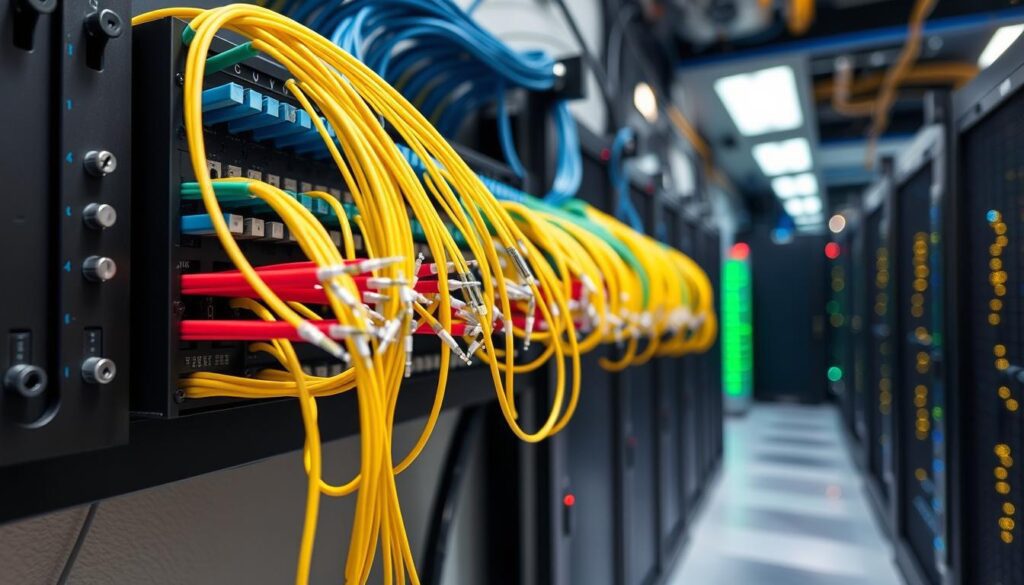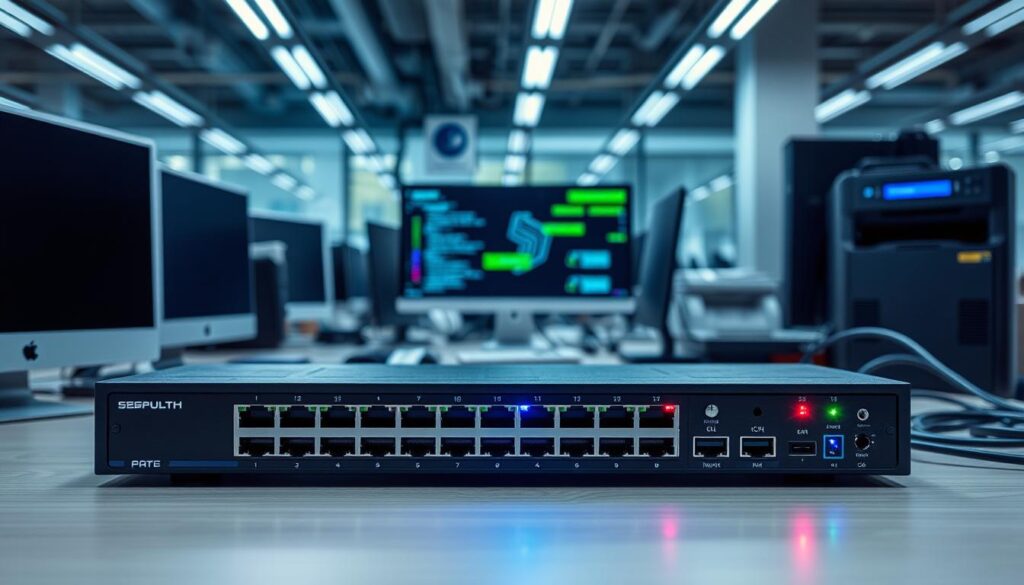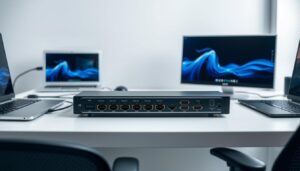Patch Panel vs Network Switch. Patch panels and network switches are frequently mentioned when discussing network configuration. A network switch directs data to the appropriate location, much like an intelligent traffic light. On the other hand, a patch panel is like a traffic hub, organizing connections. Knowing how these parts work is key to a network that runs smoothly.
It’s important to see how patch panels and network switches help in network design. The debate isn’t about which one is better. It’s about how they work together for smooth data flow. By looking into their differences, we can build a strong and dependable network.
Key Takeaways
- For a network to function properly, it is essential to comprehend the functions of patch panels and network switches.
- The patch panel vs network switch when creating an effective network infrastructure, comparison is crucial.
- Network switches and patch panels cooperate to provide smooth data transfer.
- The patch panel vs network switch the argument focuses on how they improve the overall network architecture rather than which is superior.
- The efficient usage of network switches and patch panels is essential to a well-designed network architecture.
- The patch panel vs network switch establishing a strong and dependable network requires dialogue.
Understanding Basic Network Components
Building a reliable network starts with knowing the basics. Network switches and patch panels are essential. Device connections and disconnections are made simple by patch panels, which aid in cable management. They use pre terminated fiber optic cable assemblies for easier setup.
Pre terminated fiber optic cable is vital for network design. It cuts down on installation time and costs. These cables work well with patch panels, keeping networks organized and efficient.
Using pre terminated fiber optic cable assemblies has many benefits. It includes:
- Reduced installation time
- Improved network scalability
- Easier cable management
Network switches also benefit from pre terminated fiber optic cable assemblies. These cables ensure fast and reliable data transfer. As networks grow, knowing how these components work together is crucial.
| Component | Description |
|---|---|
| Patch Panel | A device used to manage and organize cables |
| Network Switch | A device used to connect multiple devices within a network |
| Pre Terminated Fiber Optic Cable | A type of cable designed to simplify installation and reduce costs |
Patch Panel vs Network Switch: Key Differences
In network infrastructure, knowing the distinctions between a patch panel and a network switch is essential. One passive component that aids in managing fiber optic cables is a fiber optic patch panel. Conversely, a network switch is operational and links numerous devices within a network. Their cost, management, and function are where they diverge most.
When looking at patch panel vs network switch, it’s important to know their roles in network design. A patch panel is a central spot for cable connection and management, making network upkeep easier. A network switch, however, is key for data sharing between devices, ensuring smooth communication.

- Active vs passive components: Network switches need power, while patch panels don’t.
- Management capabilities: Switches offer advanced features like VLAN support and Quality of Service (QoS). Patch panels provide basic connectivity.
- Cost considerations: Patch panels are cheaper, making them a good choice for smaller networks.
Knowing the differences helps network admins choose the right component for their network. This ensures data is transmitted efficiently and reliably.
Benefits of Using Patch Panels in Network Design
When setting up a network, using patch panels is key. They make the network simpler by having all cables in one spot. It’s critical to understand proper fiber optic cable splicing techniques. This entails preparing the cables and joining them using a mechanical or fusion splice.
Patch panels offer many advantages. They make the network grow easier, save money, and are easier to manage. They let network admins add or remove devices without hassle. This makes growing the network simple. Also, they cut down on the cost of expensive and time-consuming cable setups.
- Improved network scalability
- Reduced costs
- Enhanced manageability
- Simplified cable management
Knowing the benefits of patch panels and how to splice fiber optic cable helps network admins. They can build a reliable and efficient network that fits their organization’s needs.
Network Switch Applications and Advantages
Network switches are key in managing data flow in networks. They help ensure reliable and efficient communication between devices. Additionally, they manage fiber optic cable termination, which is essential for network architecture.
Fiber optic cables must be terminated correctly. It prevents signal loss and ensures fast data transmission.
Some key benefits of network switch applications include:
- Improved network security features, such as access control and intrusion detection
- Enhanced scalability options, allowing for easy expansion of the network as needed
- Increased network reliability, with features like redundancy and failover
Network switch applications are diverse and can be used in various settings. Both small office networks and huge company networks can benefit from them. Organizations may make well-informed decisions regarding their network architecture by being aware of the benefits of network switches. This guarantees the efficiency, dependability, and security of their network.

Data Flow Management
Data flow management is a critical aspect of network switch applications. Network switches must manage data flow efficiently to prevent congestion. This ensures reliable communication between devices.
This is especially important in networks that rely on fiber optic cable termination. Signal loss can significantly impact network performance.
Network Security Features
Network security features are essential in network switch applications. Access control, the detection of intrusions, and encryption are a few of the security elements that network Switches offer. These characteristics shield the network from malevolent activities and illegal access.
They ensure that sensitive data remains secure.
Installation and Maintenance Considerations
Proper cable management is key when setting up and keeping network infrastructure running. Cable management best practices help keep cables tidy, labeled, and simple to reach. These practices stop cable damage, cut down on downtime, and help solve problems faster.
Knowing how to terminate fiber optic cable is also vital. This means getting the cable ready, removing the outer layers, and attaching a connector or splice. This ensures strong connections and less signal loss.
For your network to last, think about lifecycle expectations. Plan for upkeep, updates, and replacements. This avoids unexpected outages, saves money, and keeps your network running smoothly.
Cable Management Tips
- Use cable ties and labels to keep cables organized
- Route cables through designated pathways to prevent damage
- Check cables frequently for indications of deterioration.
Your network will be dependable, effective, and easy to maintain if you follow these guidelines and value cable management. Effective cable management is essential for optimal performance whether you’re establishing a new network or maintaining an existing one.
In conclusion: Making the Right Choice for Your Network Infrastructure
Patch Panel vs Network Switch. It’s critical to comprehend the distinctions between network switches and patch panels. Your unique demands will determine which option is best for you. Patch panels are great for simple cable management and are cost-effective. Network switches, on the other hand, offer advanced data flow control and security.
When picking the right network components, think about your network’s size and complexity. Also, consider if you need advanced management features and your budget. Knowing the strengths and weaknesses of each helps you make a smart choice for a reliable network.
The requirements and available resources of your network will determine whether to use a patch panel or a network switch. You may build a network that supports the objectives and expansion of your company by carefully weighing your options and consulting with professionals.
FAQ
What is the variation between a patch panel and a network switch?
One passive component that aids in network cable organization is a patch panel. A network switch, on the other hand, is active. It directs data between devices on a network.
What benefits come with using fiber-optic cable assemblies that have already been pre-terminated?
There are several advantages to pre-terminated fiber optic assemblies of cables. They make installation quicker and connections more reliable. They also save on labor costs compared to on-site termination.
How do I properly terminate fiber optic cable?
To properly terminate fiber optic cable, you need to follow certain steps. First, cleave the fiber. Then, insert it into a connector. Finally, polish the end face. For a good connection, always use the appropriate tools and adhere to the manufacturer’s recommendations.
Which cable management techniques work best when utilizing a patch panel?
For good cable management with patch panels, use cable trays. Organize cables by color or port. Also, check and maintain the panel regularly to avoid tangles or damage.
How can I diagnose problems with my network switch?
Checking the LED indicators is the first step in troubleshooting network switch issues. Check the port connections after that. Furthermore,, you may need to use diagnostic software or upgrade the firmware. Follow the manufacturer’s directions at all times and if you are unable to fix it, Seek expert help.







Your point of view caught my eye and was very interesting. Thanks. I have a question for you.